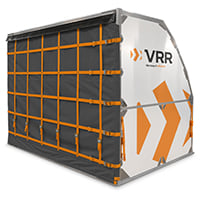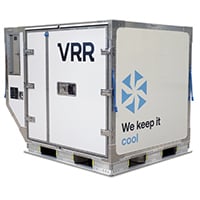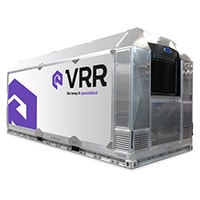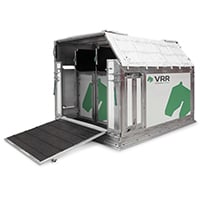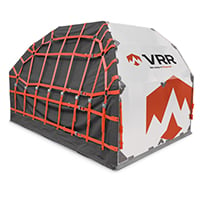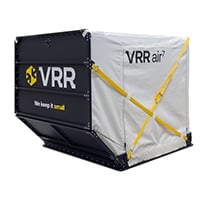The cargo industry has seen a sharp increase in shipments of lithium-based batteries in recent years. That should come as no surprise—these compact batteries carry a tremendous amount of energy despite their size, and they use an affordably priced raw material that is in ample supply.
No wonder lithium batteries are so popular among producers and users of renewable energy, mobile devices and electronic consumer products.
But there is no escaping the fact that they also present a serious fire risk.
It’s a complex issue that has got scientists and engineers scratching their heads, but VRR was determined to play its part in finding a solution that enables airlines to transport these Dangerous Goods safely.
Update 27-06-2018:
Visit our Fire Resistant Container productpage here.
Lithium batteries: the inbuilt danger for the cargo industry
Lithium-based batteries have numerous applications: from electric cars and industrial energy storage systems to laptops, e-cigarettes and artificial pacemakers.
There are two types of lithium batteries: lithium-ion and lithium-metal. Both have their pros and cons. However, both versions can self-ignite.
It is that ability to combust instantaneously that makes lithium batteries inherently dangerous to aircraft and other forms of transportation.
"Global Market Insights expects the lithium-ion battery market for consumer applications to exceed $14 billion by 2024, thanks to a growing demand for portable electronic devices."
Lithium fires too hot for an aircraft’s fire suppression system
The inherent risk of lithium batteries comes from its potential to occasionally short circuit. This can result in the battery catching fire and venting toxic and flammable gases (known as a “thermal runaway”).
Thermal runaway events are, thankfully, still relatively rare, but when they happen they tend to hit the headlines. That’s especially true when they take place on board a plane.
"Between 1991 and 2016, the US Federal Aviation Administration (FAA) recorded 138 airport and air incidents involving lithium batteries." (FAA, 2017)
The ability to self-ignite is a real and obvious cause for concern, and finding the safest way to stow lithium batteries on planes has occupied safety aviation experts for many years now.
Current fire suppression systems on board aircraft are not yet capable of tackling lithium fires. Yes, they can extinguish the flames. What they can’t do is stop the temperature of the lithium cell from rising, and it is this which can lead to a thermal runaway.
Tests show that the heat from a lithium fire can exceed 1,000°C. That’s exceptionally hot.
The strength of steel structures drops by about 40% when exposed to temperatures exceeding 500°C, and aluminium—a common metal used to construct most airplanes and ULDs today— melts at around 630°C.
It’s that intense heat that is so worrisome. It can spread easily to other devices or battery cells within the overpack, the ULD or even the aircraft cargo hold. The result is re-ignition. That can lead to a thermal runaway in other lithium cells, causing a chain reaction. An explosion may follow, which could damage and even bring down an aircraft.
And that is the stuff of nightmares.
"In 2016, lithium battery failures reported to the FAA involved 13 e-cigarettes, four laptops, seven mobile phones/tablets and seven spare batteries." (FAA, 2017)
Complex regulations can’t stop the risk of short-circuiting
Cargo handlers in distribution hubs blame incorrect packaging for battery failures, according to Isidor Buchmann, founder and CEO of Cadex Electronics Inc. They believe that most battery-related incidents caused by a short circuit could have been prevented with proper packaging and correct cargo handling.
Regulations are being developed and implemented to deal with this issue, including the classification of lithium batteries as Dangerous Goods. But therein lies a problem, says the Corporate Safety Department of Cathay Pacific in its report “Lithium Battery — Risk Mitigation”.
While everyone agrees that prevention is better than cure, regulations are complex and constantly changing, and training is proving to be very challenging. This is despite IATA developing guidance for shippers, freight forwarders, ground handlers, airlines and passengers.
However, one of the biggest worries is the lack of declaration.
Whether it’s intentional or not, not all shippers are declaring lithium batteries in their cargo shipment. Cathay Pacific's report mentions that several thousand undeclared lithium batteries have been discovered on arrival.
Finding new ways to contain a lithium fire during flight
The airline and cargo industries are working hard to find solutions to the lithium battery problem. To begin with, two levels of risk can be identified:
- Undeclared Dangerous Goods (e.g. a single lithium battery failure in a ULD with express mail/packages). The resulting fire would be classified as a Class A fire, a fire with combustible materials such as paper/carton, plastics and wood as the fuel source.
- Declared Dangerous Good (e.g. lithium battery failure in a ULD containing a bulk load of batteries). Bulk shipments are no longer permitted on passenger aircraft but they are still allowed on freighter aircraft. The resulting file would be classified as a Class D fire, a fire that has ignitable metals as a fuel source.
The fire’s location on an aircraft has also been considered in relation to fire containment and suppression:
- Class C compartment (lower deck of passenger or freight plane): Fire protection is built into the aircraft. It relies on detecting the fire early and suppressing it for the rest of the flight. The fire suppression system releases an extinguishing agent like Halon into the compartment at a level that prevents combustion. However, it cannot currently deal adequately with lithium fires (Class D).
- Class E compartment (permitted only on a freighter plane): Fire protection is limited to smoke or fire detection and shutting off the ventilating airflow so that hazardous smoke and gases do not enter the flight crew compartment. The lack of a fire suppression and containment system means that a Class A or D fire poses a substantial risk to the plane.
Undeclared lithium battery cargo a constant hazard
Solutions are coming in from all areas and tackle various aspects of the risk. The FAA has banned the shipment of lithium-ion batteries as cargo on passenger aircraft, for example, while IATA has issued instructions are the safest way to pack lithium batteries.
These measures undoubtedly contribute to the overall fire safety of an aircraft. However, it’s generally accepted that there will always be a certain amount of undeclared lithium battery cargo and that not all manufacturers and shippers will follow safety rules, whether through ignorance or intent.
There will always be a number of disreputable individuals and companies who disregard fire safety measures to make a fast buck, irrespective of the consequences. This means that the industry must continue to develop detection, suppression and extinguishing systems for lithium fires in cargo holds.
Criteria for fire-resistant containers (FRCs) set the bar
IATA is already promoting global standards for the design and use of FRCs and fire containment covers, which gave us a starting point.
ISO 19281:2016 sets out the minimum design and performance criteria and testing methods of passive FRCs carrying unitised cargo in main-deck compartments (FRCs are not intended for lower-deck Class C compartments since they may hamper the compartment’s fire detection and suppression system).
Basically, an FRC must pass three ISO tests:
- Full-scale test: the FRC is filled with carton boxes that contain shredded paper. One box is set on fire to simulate a Class A fire, and the FRC must contain the fire for a minimum of six hours.
- Flame penetration test: The sheet material for e.g. the panels and door must be subjected to a burner at a temperature of approximately 1,000°C for at least five minutes without developing a hole, and the temperature on the other side of the tested material (10 cm away) may not exceed 204°C.
- Vertical burn test: The sheet material for e.g. the panels and door is positioned vertically and set on fire; it may not exceed an average burn speed.
VRR's main design challenges for an FRC
VRR’s approach to the lithium battery puzzle is to develop a fire-resistant container (FRC) that is affordable, sustainable, easy to load and repair and that is only slightly heavier than a typical ULD.
Over the course of many months, we carried out extensive research into the best design and materials for an FRC. We subjected a variety of sheet and cover materials to fire and durability tests.
We also put a selection of ULD types and designs through their paces in full-scale tests. To learn about the behaviour of lithium batteries we also conducted multiple lithium fire tests (e.g. lithium battery test with 35 cells, see video).
There were many challenges when it came to the ULD design. The main ones are as follows:
- The seals of a typical air container cover allow oxygen into the ULD, but oxygen is a main source of fire. Therefore, we put a lot of effort into optimising the cover design to ensure it seals the container tightly enough that it restricts oxygen flow as much as possible.
- The material of ULD covers typically have a very low melting point and are not designed to withstand any type of fire. Finding a suitable cover material that met all requirements has proved rather difficult. It has to meet ISO standards, deal with the high temperatures of lithium fires, withstand rough operational conditions (weather and handling) and still be affordable.
- The sheet material of most ULDs is usually made of aluminium or composite materials, which have a low melting point. Even so, our full-scale Class A fire tests with aluminium sheets and fire-resistant cover design could contain the fire to six hours. However, since aluminium sheet does not meet ISO standards and (theoretically) cannot withstand lithium fire temperatures, we had to find another sheet material that does meet the standards and can deal with the high temperatures of lithium fires.
- During our research, we discovered that composite materials would be able to pass the ISO material flammability/durability tests. Unfortunately, we found these composite materials to be quite expensive. What’s more, they make the ULD more difficult and expensive to maintain because they require a different repair method. Eventually, we developed and successfully tested a special metal alloy for the sheets. This alloy has similar mechanical and repair properties to aluminium and is also affordable.
- The net material of the container is not only critical for holding loads but also for holding the container’s cover in place. Unfortunately, today’s net material typically has a low temperature melting point and melts even when not in direct contact with the flames. We managed to incorporate some design features into the FRC range so that it holds the cover in place once the net has melted.
VRR's extensive research leads to two FRCs
Our painstaking research over many months has resulted in two FRC designs with different safety levels:
- An FRC with aluminium sheets and a fire-resistant cover design which passes the full-scale Class A fire test, as described in ISO 19281:2016. However, the aluminium sheets do not pass the ISO material flammability tests. This means that, theoretically, they cannot withstand the temperatures that lithium fires can reach because aluminium melts at around 630°C.
- An FRC constructed from special metal alloy sheets instead of aluminium sheets, which do meet ISO 19281:2016 and are able to withstand the temperature of lithium fires.
DHL becomes first FRC customer for VRR
The demand by airlines and integrators for fire-resistant containers has been increasing steadily over the years, due partly to the understandable safety concerns expressed by pilots.
DHL has responded to this demand by adapting the specifications of its containers. From now on, all the containers that it purchases must comply with the requirements for Class A fires and, in the longer term, even Class D fires.
VRR’s efforts to create an FRC have been recognised by DHL. It currently has in operation a series of 400 containers (and counting), including LAY, AMJ and ALP containers.
VRR now aims to design a "Class D" fire-resistant ULD
Our next step is to develop an FRC that can contain a fire within a bulk load of lithium batteries. We’ve already been testing material for the panels, frame and door, and we are optimistic that it will be able to withstand the intense heat of a lithium fires.
Now we’re testing to optimise the FRC design to be able to deal with the aggressive venting behaviour of gases generated by bulk lithium fires. Full-scale tests will start soon.
Interested in our fire-resistant containers?
If you’d like to know more about our FRCs, please contact us or visit the productpage for our Fire Resistant Containers.
